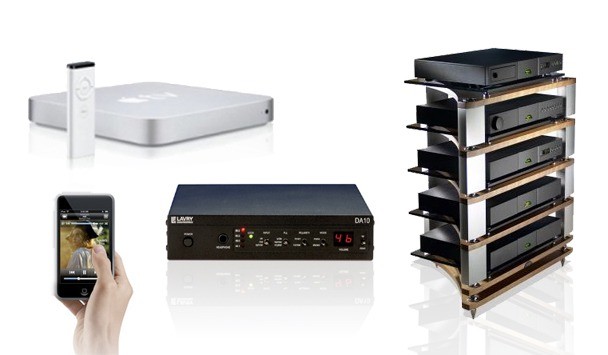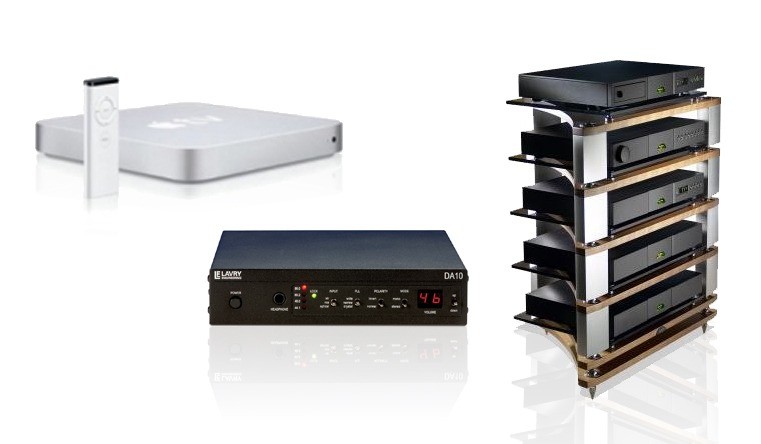Apple TV (ATV – first generation) with all it’s connectivity and a built in hard drive is great for audiophile music playback. Here’s how we did it

I’m surprised more people don’t do this. In case you don’t know, the (soon to be refreshed?) AppleTV (Apple TV) is a device the size of a few CDs stacked on top of each other that has all the video and audio connections you could need or want in this modern age.
It’s designed to bring your iTunes content from your computer right into your living room and onto your TV. As an added bonus, it also works nicely on its own with the ability to rent any buy content from iTunes directly onto the AppleTV. I’ve used this feature a few times and it works really well. You can start watching the movie within seconds of “renting” and I’ve never had a problem with playback. There’s also a handy little ‘upgrade’ from ATVFlash which unlocks all of the features you were probably expecting in the first place, such as the ability to use the USB port or support for other file formats. You can watch YouTube directly on your TV which can be great fun, and it even syncs with your photos for embarrassing moments at parties should you forget to uncheck the “sync all” option. Of course why you’d keep anything like that in your iPhoto library in the first place raises deeper questions beyond the scope of this article. You know who you are!
So onto the meat and potatoes, as it were. The AppleTV for Hi-Fi use is brilliant. It syncs to your music library just like an iPod, and, crucially, has an optical output so you can take advantage of a nice outboard DAC to do the conversion from digital to analogue. In our system we’re using a Lavry DAC, and the sound quality is superb. There’s also HDMI so if you have a decent amp with HDMI connections you can use that. What makes it even better is that the iPhone/iPod Touch has a free app from Apple called “Remote”. After authenticating once, this connects to any iTunes library and functions in much the same way as the iPod function on the iPhone itself. You can play tracks, playlists, search for artists etc etc. Since the inte5rnal drive is reasonable large these days (200GB+) it’s also possible to store most people’s entire library. If you’ve been a bit more wayward with your music purchases, you can (with the addition of ATVFlash), plug a USB drive into the port on the back and extend the storage even further, or just pop the lid and replace the internal drive as capacities increase. For our uses the 250GB internal drive is fine, and we can access the music without having to turn on a screen. Of course if you do have the screen fired up, the Remote app also gives you the iPhone keyboard for text entry (YouTube without it is painful) and a large touchpad for mouse duties. Hehe. He said mouse duties.
The AppleTV also functions as a speaker-out for your iTunes libraries so without dangling cables everywhere you can stream music wirelessly from the laptop to the Hi-Fi via the AppleTV and your DAC. Of course the quality of your audio doesn’t just depend on the converters, although this is one of the most significant sonic upgrades we ever made. The other is the quality of the source, and whilst mp3 is fine for some, uncompressed audio is the standard for audiophiles and music lovers. I’ve yet to find a solution better than Exact Audio Copy on the PC. In fact it’s one of the few reasons I still have a windows virtual machine on my Mac. EAC does bit-for-bit ripping of CDs, bypassing the error corrections and interpolation that CD players do by default. What you end up with at the end of the rip is an exact copy of the CD, not a close approximation. This is a similar technology to that used in high-end kit like the Naim HDX, but it’s free. Yes, free.
“But what about my iPod? If I rip to AIFF I’ll be able to fit hardly anything on there?” I hear you cry. Not so, replyeth I. There’s a nice new checkbox on the properties page of your iPod since iTunes 9.1 entitled “Convert higher bit rate songs to 128 Kbps AAC”. This tells iTunes to transcode, whilst syncing, your tracks to a 128k AAC version so you can fit a LOT more music on your iDevice. Personally I don’t bother as I’d rather have less music and better sound quality. But then I am an audiophile…
A lot of us spend all day looking at a screen, and the advent of computer based music storage has meant it is difficult to escape this, even if we just want to relay and listen to music at home. The AppleTV plus the Remote app on the iPhone sorts this out. It’s the closest I’ve yet come to having a CD player again, but with the convenience of hard disk storage. In our Naim Hi-Fi system, this totally rocks and is several thousand pounds cheaper than the dedicated solution we looked at from any of the major players in home audio. An AppleTV combined with a Lavry (or other good high-end) DAC and an iPhone/iPod touch will set your hi-fi world on fire, and you’ll spend around a grand to do it, assuming you haven’t already got a good DAC. If you don’t have an iPod touch or an iPhone then this is as good an excuse as any. It’s cheaper than a touchscreen remote. If the rumours are to believed, Apple will soon be updating the AppleTV, so prices for the current model on the second hand market will likely fall. Either way, you can pick them up now on eBay for around £150. Combine that with your DAC and you have a great little music player whose sound quality is limited only by the ripping process and the DAC.
Highly recommended.

